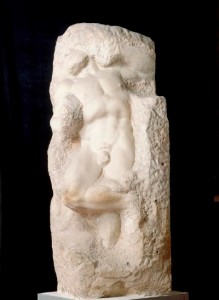Recently someone asked me what the difference was between PLC programming and PC programming. This was a topic I’ve talked about before, and I gave him the same old answer I’d already come up with, but it got me thinking about it again.
Now I have a new way to compare PC programming and PLC programming: PC programming is like brick-laying and PLC programming is like sculpting.
When you write a PC program, you start out by writing the least amount of code you can to get a functional program. You run and debug that. You check it in to source control, and then you repeat the cycle, building a little more, testing it, and at regular intervals you show it to a customer, get feedback, and change direction, but you always work in small increments because it’s easier to build it that way. You make sure you’ve built a solid foundation, and then you build more on top.
 On the contrary, the first time you download a PLC program to a new machine, you have a fixed number of outputs that you have to account for. You can’t just program one axis of motion first without taking into account the position of other axes on the machine (unless you enjoy the sound of metal deforming). So you start by writing logic for all the outputs and you load on more and more conditions that prevent the motion from occurring until you’re absolutely sure that nothing will move unless it’s absolutely safe. Of course, when you download this program to the machine, nothing moves, no matter what buttons you push. This is actually a good place to be. In some cases you actually put conditions in that you know could never be true, just to make sure nothing will move until you’re really sure you want it to.
On the contrary, the first time you download a PLC program to a new machine, you have a fixed number of outputs that you have to account for. You can’t just program one axis of motion first without taking into account the position of other axes on the machine (unless you enjoy the sound of metal deforming). So you start by writing logic for all the outputs and you load on more and more conditions that prevent the motion from occurring until you’re absolutely sure that nothing will move unless it’s absolutely safe. Of course, when you download this program to the machine, nothing moves, no matter what buttons you push. This is actually a good place to be. In some cases you actually put conditions in that you know could never be true, just to make sure nothing will move until you’re really sure you want it to.
In a letter from 1549, Michelangelo defined sculpture as the art of “taking away” not that of “adding on” (the process of modeling in clay), which he deemed akin to painting. (Reference)
Now that you’ve downloaded your logic to the PLC, debugging and commissioning the machine is largely a matter of taking away those conditions that you didn’t really need. This is done one motion at a time until the machine does exactly what you want, when you want, but only that. Your PLC program is done, not when there’s nothing left to add, but when there’s nothing left to take away.
That is, until you add a data collection system…
Nice analogy. I like it!
Gotta say you nailed that one…I thought I was the only one that started PLC logic that way.